Seed Oils: Separating Fact from Fiction, Part 3

So far, I have reviewed what seed oils are, their nutritional characteristics, and some of the properties that have made them targets of scorn. I’ve also pointed out the nuances behind the negative claims and tried to put common concerns in context. My overall conclusion is that the arguments against seed oil consumption are truly overblown. Especially since, if anything, higher intakes of linoleic acid (LA, omega 6 fatty acid) are associated with LOWER mortality rates.
Having said that, I’m not suggesting you consume seed oils with wild abandon or ignore their ubiquity in our food supply.
Quantity and Context Matter
Seed oils may have redeeming qualities when consumed in reasonable amounts, but because they are everywhere and in everything, we are probably consuming too much of them. And too much of a good thing can be detrimental to health. Drink 6 glasses of water in a day and stay well hydrated. Drink 6 liters (about 1.5 gallons) and die.
The delivery vehicle matters too. Drink 6 glasses of pure water and give your body what it needs. Drink 6 glasses of water in the form of Diet Mountain Dew® and flood your body with caffeine and non-nutritive sweeteners, while exposing your teeth to a significant acid load.
Consume 15 grams of linoleic acid and support health. Consume nearly 40 grams, like most Americans do, and take your chances.
But if I were to point to the biggest concern about seed oils, it’s not that we get too much (which we do), it’s that we get them in the wrong context. Sautéing vegetables in a bit of canola oil is not the same as consuming it in the form of Chips Ahoy® cookies. And this is where it gets really difficult to tease out the health effects of any seed oil. After all, is it the canola oil that's the problem or is it the high fructose corn syrup, artificial flavor and caramel color that are the real culprits in making us sick? Would those same cookies be automatically good for us if they were just made with butter or lard?
The Balance is Off
The imbalance in ALA (alpha linolenic acid, omega 3) and LA (linoleic acid, omega 6) consumption created by the ubiquity of seed oils in our foods is also an issue. ALA and LA use the same chemical pathways in order to be converted into other substances. In the case of ALA, that conversion leads to EPA and DHA - the omega 3 fatty acids that are most biologically active and have the greatest health benefits. But if the chemical pathways are overwhelmed by an over-abundance of LA, LA conversion to arachidonic acid will predominate and production of EPA and DHA will suffer.
So seed oils may be “pro-inflammatory” not so much because they cause inflammation on their own, but because their over-consumption leads to under-production of EPA and DHA, which are highly anti-inflammatory.
One takeaway is that we need to balance our intake of omega-6 and omega-3 fats. Incorporating more omega-3-rich foods (like salmon, walnuts, and flaxseeds) - while reducing processed foods - can help restore this balance.
It’s important to acknowledge that not all experts are concerned over PUFA ratios. Their argument is that if studies are showing overall health and survival benefits related to higher omega-6 intake, maybe we should stop worrying about omega 6s and just focus on getting enough omega 3 fatty acids in our diets. There’s some wisdom in that line of thinking.
Some Advice Never Gets Old
If you’re a regular reader of my blogs, you know that I often invoke a quote from Michael Pollan, the author of several books on food and our relationship to it. I consider it the best dietary advice ever - because it is as simple as it is profound:
"Eat food. Not too much. Mostly plants."
The “eat food” part is important because this refers to REAL food. Food that you make - with ingredients that have been used for millennia. And many seed oils have been around for thousands of years! So you can absolutely stay true to this advice when it comes to consuming seed oils, especially in the context of supporting heart health. Here’s how to be most strategic:
-
Rotate your oils – Use olive oil for low-heat cooking, canola or avocado oil for higher-heat cooking, and flaxseed or walnut oil for dressings.
-
Watch your portions – Even healthy oils are calorie-dense, so be mindful of how much you’re using.
-
Prioritize whole foods – Focus on consuming whole food sources of PUFAs (like nuts, seeds, fish and avocados) alongside seed oils to help support a balanced fat profile.
As I think about my own diet, I don’t consume many seed oils in liquid form. I rarely cook with them and I don’t buy much processed food. I do however eat plenty of nuts and seeds, fish and avocados. And I have at least one serving of Step One Foods every day.
Seed Oils and Step One Foods
Oils from seeds are naturally present in Step One Foods products because our foods contain flax and chia. Nuts also add to the PUFA content of our products. We have purposefully prioritized these ingredients to ensure our foods deliver plenty of ALA and relatively little LA (because we know omega 3s are the fatty acids most people are not getting enough of).
Sunflower oil can be found in the ingredient section of some Step One Foods items. It’s important to clarify that we don’t add sunflower oil to our products, rather it is an intrinsic accompaniment to the dried fruit (blueberries and cranberries) added by the dried fruit suppliers. It helps keep the dried fruit from sticking together in a giant un-breakable and un-useable clump - and is present in only minuscule amounts (less than 1% of the dried fruit component by weight).
I point this out not to apologize for our ingredient panel. Rather, I want to provide some quiet context, which can be easily lost when all you hear are people screaming online.
Some Final Thoughts
-
Seed oils have been unfairly maligned. They have many redeeming nutritional qualities and can be included in a dietary pattern that supports health. If you use them in reasonable amounts and in balance with more robust sources of ALA (like Step One Foods), you will be fine - even better off, as our clinical trial demonstrates.
-
If the seed oil hysteria teaches us anything, it is that the biological effects of foods and ingredients on our bodies are complex, and not always predictable. We should be highly suspicious of concerns that are raised about one food component (like lectins) or one biologic pathway (like LA being metabolized into arachidonic acid).
-
Contrary to what influencers online might want you to believe, we cannot look at ANY food or ingredient in isolation. Because we never consume any food or ingredient in isolation! At least not for long. We have to look at the health effects of every ingredient/food more holistically while considering two fundamental questions: With what? and: Instead of what?
- If you’re consuming seed oils as part of a diet full of ultra-processed foods, those seed oils are probably the least of your concerns. If you’re consuming them as part of a whole-food, plant centric diet, and in reasonable amounts, relax. You’re good.

Tested & Proven Results.
- Cardiologist formulated
- Supported by over 500 publications
- Clinically-proven, in a double-blind randomized trial with Mayo Clinic and The University of Manitoba
80% of participants lowered their cholesterol in just 30 days. With just two servings per day, Step One Foods offers a proven-effective way to naturally lower LDL (bad) cholesterol.
Get heart health tips and articles like this, delivered right to your email.
New articles every week.
You may also like...

You don’t need to avoid foods with cholesterol…except for these




